I am trying to plot a scatterplot matrix based on the code written by Joe Kington: Is there a function to make scatterplot matrices in matplotlib?
Some people already helped me: Thank you again (especially J.K.).
I am having a last problem: I cannot rotate the ticks of some axis for which numbers overlap (bottom left):
I would like to try to have them vertical but I cannot do it.... Here is my code:
import itertools
import numpy as np
import pylab as plot
import scipy
import matplotlib
import matplotlib.pyplot as plt
from matplotlib import axis
import math
from matplotlib import rc
import os
import platform
def main():
FigSize=8.89
FontSize=8
np.random.seed(1977)
numvars, numdata = 4, 10
data = 10 * np.random.random((numvars, numdata))
fig = scatterplot_matrix(data, ['mpg', 'disp', 'drat', 'wt'], FigSize, FontSize,
linestyle='none', marker='o', color='black', mfc='none', markersize=3,)
fig.suptitle('Simple Scatterplot Matrix')
plt.savefig('Plots/ScatterplotMatrix/ScatterplotMatrix2.pdf',format='pdf', dpi=1000, transparent=True, bbox_inches='tight')
plt.show()
def scatterplot_matrix(data, names, FigSize, FontSize, **kwargs):
"""Plots a scatterplot matrix of subplots. Each row of "data" is plotted
against other rows, resulting in a nrows by nrows grid of subplots with the
diagonal subplots labeled with "names". Additional keyword arguments are
passed on to matplotlib's "plot" command. Returns the matplotlib figure
object containg the subplot grid."""
legend=['(kPa)','\%','\%','\%']
numvars, numdata = data.shape
fig, axes = plt.subplots(nrows=numvars, ncols=numvars, figsize=(FigSize/2.54,FigSize/2.54))
fig.subplots_adjust(hspace=0.05, wspace=0.05)
sub_labelx_top=[2,4]
sub_labelx_bottom=[13,15]
sub_labely_left=[5,13]
sub_labely_right=[4,12]
for i, ax in enumerate(axes.flat, start=1):
# Hide all ticks and labels
ax.xaxis.set_visible(False)
ax.yaxis.set_visible(False)
ax.xaxis.set_major_locator(MaxNLocator(prune='both',nbins=4))
ax.yaxis.set_major_locator(MaxNLocator(prune='both',nbins=4)) #http://matplotlib.org/api/ticker_api.html#matplotlib.ticker.MaxNLocator
# Set up ticks only on one side for the "edge" subplots...
if ax.is_first_col():
ax.yaxis.set_ticks_position('left')
ax.tick_params(direction='out')
ax.yaxis.set_tick_params(labelsize=0.75*FontSize)
if i in sub_labely_left:
ax.yaxis.set_label_position('left')
ax.set_ylabel('(\%)',fontsize=0.75*FontSize)
if ax.is_last_col():
ax.yaxis.set_ticks_position('right')
ax.tick_params(direction='out')
ax.yaxis.set_tick_params(labelsize=0.75*FontSize)
if i in sub_labely_right:
ax.yaxis.set_label_position('right')
if i==4:
ax.set_ylabel('(kPa)',fontsize=0.75*FontSize)
else:
ax.set_ylabel('(\%)',fontsize=0.75*FontSize)
if ax.is_first_row():
ax.xaxis.set_ticks_position('top')
ax.tick_params(direction='out')
ax.xaxis.set_tick_params(labelsize=0.75*FontSize)
if i in sub_labelx_top:
ax.xaxis.set_label_position('top')
ax.set_xlabel('(\%)',fontsize=0.75*FontSize)
if ax.is_last_row():
ax.xaxis.set_ticks_position('bottom')
ax.tick_params(direction='out')
ax.xaxis.set_tick_params(labelsize=0.75*FontSize)
if i in sub_labelx_bottom:
ax.xaxis.set_label_position('bottom')
if i==13:
ax.set_xlabel('(kPa)',fontsize=0.75*FontSize)
else:
ax.set_xlabel('(\%)',fontsize=0.75*FontSize)
# Plot the data.
for i, j in zip(*np.triu_indices_from(axes, k=1)):
for x, y in [(i,j), (j,i)]:
axes[x,y].plot(data[y], data[x], **kwargs)
# Label the diagonal subplots...
for i, label in enumerate(names):
axes[i,i].annotate(label, (0.5, 0.5), xycoords='axes fraction',
ha='center', va='center',fontsize=FontSize)
# Turn on the proper x or y axes ticks.
for i, j in zip(range(numvars), itertools.cycle((-1, 0))):
axes[j,i].xaxis.set_visible(True)
axes[i,j].yaxis.set_visible(True)
return fig
main()
My second question is more for the 'fun': how can I make the subplots perfectly squares?
I apologize to Joe Kington; I know my code is way less elegant than his... I just started few weeks ago. If you have any suggestions to improve mine, for example to make it more dynamic, I am very interesting.

